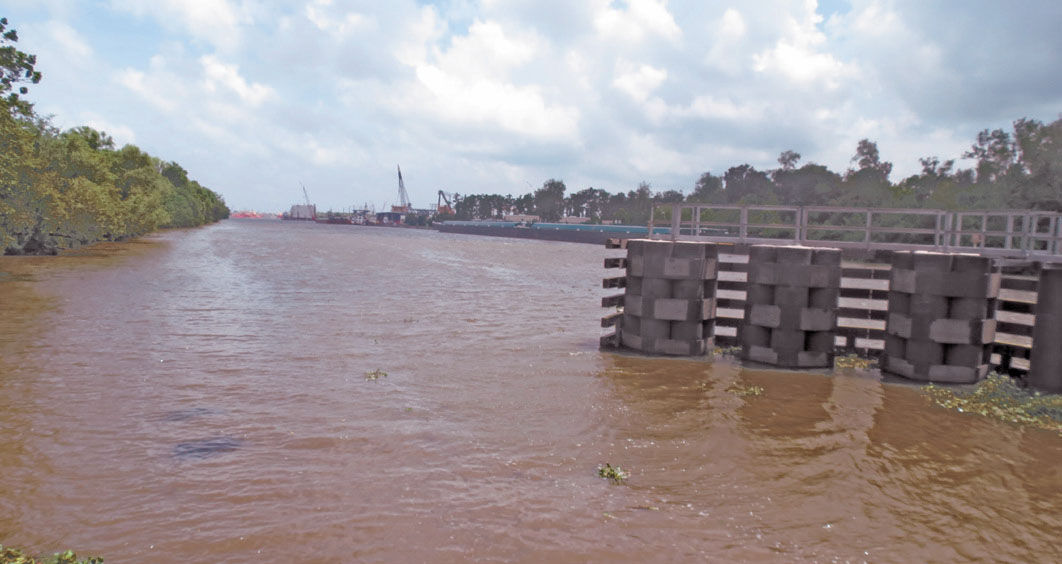
Lafourche Parish Sheriff Craig Webre walking tall
May 21, 2015Breaking: Platform fire in Gulf
May 22, 2015Built as a conduit to assist industry-and now a vital maritime artery-the Houma Navigation Canal has become in some ways a hindrance to business development, rather than a helper.
That’s because the channel, dredged to a depth of 15 feet for most of its length but rarely meeting that promise because of silting and other issues-is not deep enough to accommodate the types of vessels the deep water oil industry is using. Fabricating, ship-building and other businesses are at risk for leaving the Houma area, because of the shallow depths. But the system for getting government approval of such a widening project remains nearly insurmountable, interviews with engineers, company CEOs and port officials reveal.
“The Houma Navigation Canal is a critical artery that provides the life-blood that fuels our local economy,” Port of Terrebonne Director David Rabalais wrote in a letter to state officials, seeking their support for a deepening project. “With the deepwater oil and gas industry rapidly growing, our current authorized depth will soon be abandoned by the industry, causing a devastating downturn in our thriving economy.”
The Louisiana Department of Transportation and Development, to whom Rabalais wrote, has expressed clear support for the project. The Army Corps of Engineers itself notes the canal’s importance and several reasons why a study of the matter should occur.
And studies have been done. But no conclusive action has been taken.
Completed in 1962, the waterway branches off of the east-west Gulf Intracoastal at Houma and travels southward, giving vessels a straight shot to the Gulf of Mexico. But, as noted in a Corps letter which indicates support of a deepening project, the bottoms of large oilfield structures towed through the canal strafe and scrape the bottom.
For Gulf Island Fabrication, a major builder of ships and oilfield structures, location on the canal was seen as a boon back in the 1980s, when it was founded. A 15-foot depth was then seen as deep water, but not anymore. Now Gulf Island’s CEO, Kirk Meche, noted the problem when asked about his firm’s sense of commitment to Louisiana.
“There are certain obstacles that we must overcome to meet the demands of the industry,” he said. “Deep water exploration means bigger and heavier products
to meet the harsh environments and that translates into bigger structures that must be delivered on larger vessels. Water depth leading to our Louisiana facilities needs to be examined and action must take place to ensure our ability to deliver these products to our customers.”
The problem, Rabalais said, lies in the process by which the Army Corps is forced to do business.
Projects like the channel deepening are prioritized nationally, and must have money appropriated by Congress for them to become realities. The cost of things like feasibility studies-required by the Corps-can sometimes be raised.
But there is a catch.
Typically each component of a study is good for three years and if the project does not move forward then expired components-generally-need to be re-done.
“It is a dog chasing its tail,” Rabalais said. “They study something, then they put it aside, then by the time they finish component number six, component number one is expired.”
The Louisiana Department of Transportation and Development has been given a more active role in determining the future of the canal, but Corps approval-and congressional funding-will still be needed further down the line, and so Rabalais and other officials still can’t figure a firm timeline.
Eddie Carter, an engineer with GEC, a consulting firm in Baton Rouge that has worked on a feasibility study for the canal, is among those familiar with the proposal who have no doubt that the need for a deeper canal is, as stated, to maintain and retain fabrication shops and other businesses on its banks.
“We are given these rules to play by and it would take literally an act of Congress to change the process,” he said. “The first battle is getting authorization to do the project and then the real battle starts with getting the people to get the funding to do the work. Money will come in dribs and drabs and it gets delayed and with all good intentions in the world, then they change the requirements. They say money doesn’t solve all the woesin the world, but it would go a long way in this situation. People usually celebrate when you get a project authorized but there are lots of authorized projects that don’t get money.”
The Houma Navigation Canal looking southward from the bridge that crosses it at La. 182 in Houma, not far from its junction with the Gulf Intracoastal Waterway



